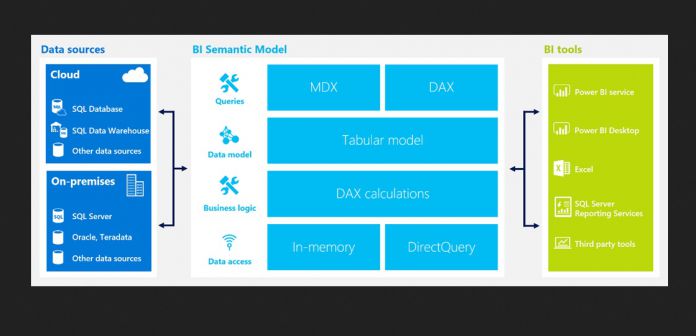Microsoft has introduced the first public preview of Azure Analysis Services. The addition to Microsoft’s cloud data platform comes with a number of features. Rapid server creation, the ability to pause and resume servers, and access to the Azure Active Directory are among the Analysis Services features. The platform-as-a-service (PaaS) is also compatible with SQL Server Analysis Services.
Azure Analysis Services is an enterprise grade OLAP engine and BI modeling platform. Microsoft presents the service as a managed PaaS. The platform is built from the same basis as SQL Server Analysis Services, giving developers and BI users tools to create BI Semantic Models. Analysis Services models can bring analytical and interactive tools to services such as Power BI and Excel.
Microsoft has detailed the features coming to developers in preview:
- Developers can create a server in seconds, choosing from the Developer (D1) or Standard (S1, S2, S4) service tiers. Each tier comes with fixed capacity in terms of query processing units and model cache. The developer tier (D1) supports up to 3GB model cache and the largest tier (S4) supports up to 100GB.
- The Standard tiers offer dedicated capacity for predictable performance and are recommended for production workloads. The Developer tier is recommended for proof-of-concept, development, and test workloads.
- Administrators can pause and resume the server at any time. No charges are incurred when the server is paused. We also plan to offer administrators the ability to scale up and down a server between the Standard tiers (not available currently).
- Developers can use Azure Active Directory to manage user identity and role based security for their models.
- The service is currently available in the South-Central US and West Europe regions. More regions will be added during the preview.
Developers can also implement BI Semantic Models into custom applications.
Professionals can build models to share with business users. This can be achieved easily by connecting to the model for data and gain insights.
Microsoft explains why the preview of Azure Analysis Services is necessary for customers:
“The success of any modern data-driven organization requires that information is available at the fingertips of every business user (not just IT professionals and data scientists) to guide their day-to-day decisions. Self-service BI tools have made huge strides in making data accessible to business users. However, most business users don’t have the expertise or desire to do the heavy lifting that is typically required to find the right sources of data, consume the raw data and transform it into the right shape, add business logic and metrics, and finally explore the data to derive insights.”
Azure Analysis Services Integrated with SQL Server
Compatibility with SQL Server Analysis Services. This allows developers to tap into SQL Server Data Tools in Visual Studio for creating and deploying models. Customers can use the models in any BI supporting tool, including Microsoft’s own Power BI and Excel.
Below are the tools and abilities developers get through SQL Server compatibility:
- Developers can use SQL Server Data Tools in Visual Studio for creating models and deploying them to the service. Administrators can manage the models using SQL Server Management Studio and investigate issues using SQL Server Profiler.
- Business users can consume the models in any major BI tool. Supported Microsoft tools include Power BI, Excel, and SQL Server Reporting Services. Other MDX compliant BI tools can also be used, after downloading and installing the latest drivers.
- The service currently supports tabular models (compatibility level 1200 only). Support for multidimensional models will be considered for a future release, based on customer demand.
- Models can consume data from a variety of sources in Azure (e.g. Azure SQL Database, Azure SQL Data Warehouse) and on-premises (e.g. SQL Server, Oracle, Teradata). Access to on-premises sources is made available through the on-premises data gateway.
- Models can be cached in a highly optimized in-memory engine to provide fast responses to interactive BI tools. Alternatively, models can query the source directly using DirectQuery, thereby leveraging the performance and scalability of the underlying database or big data engine.





